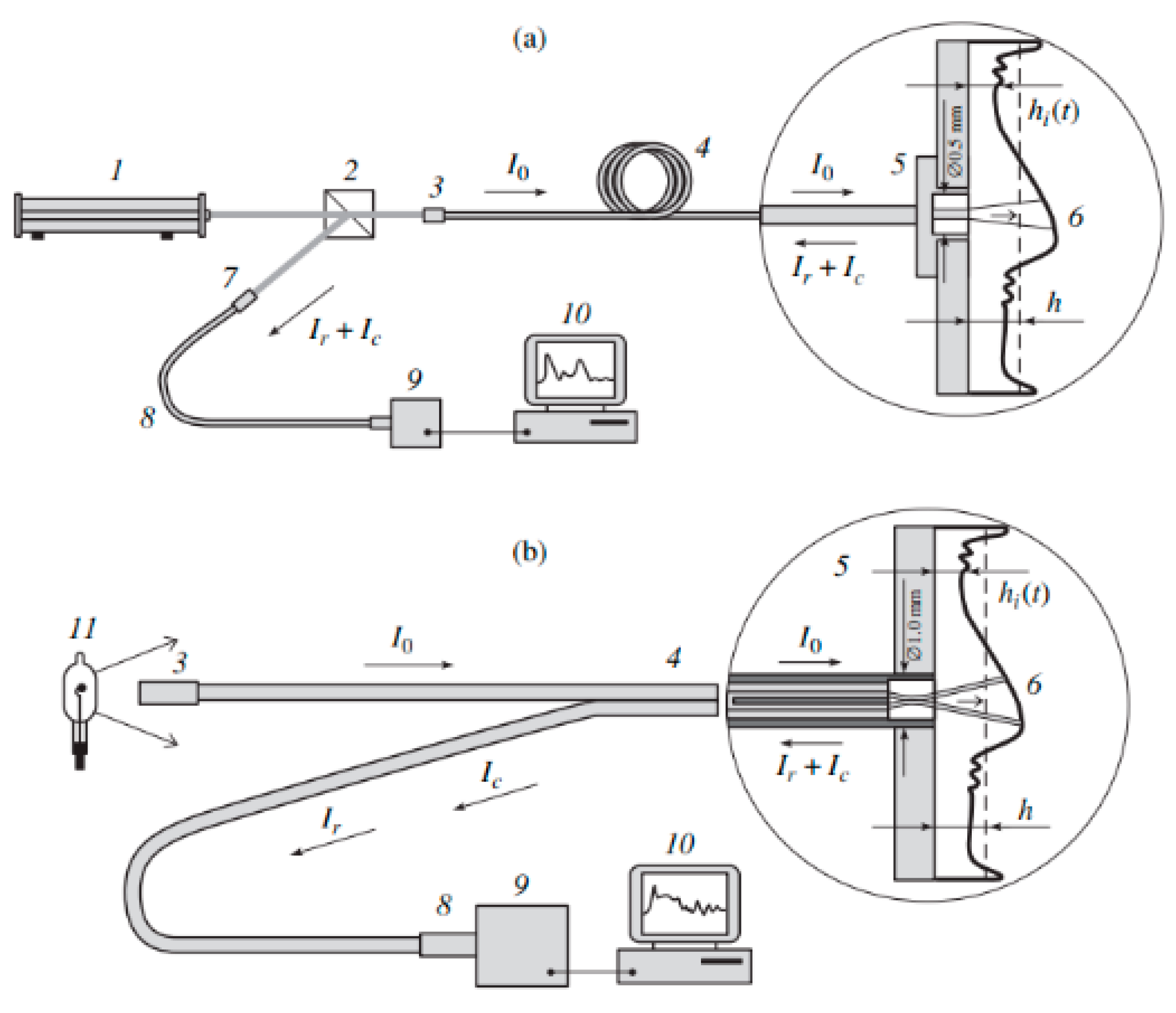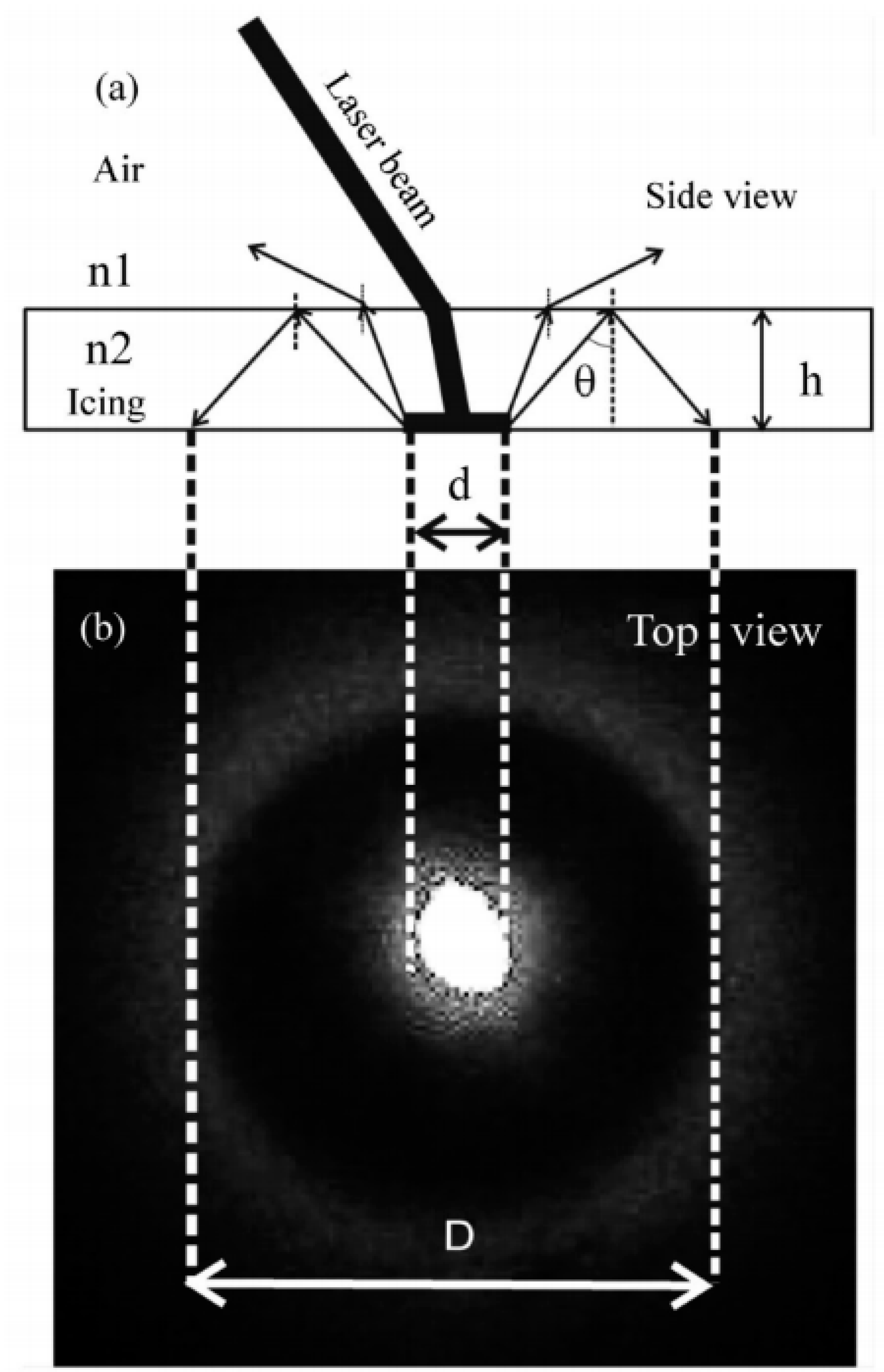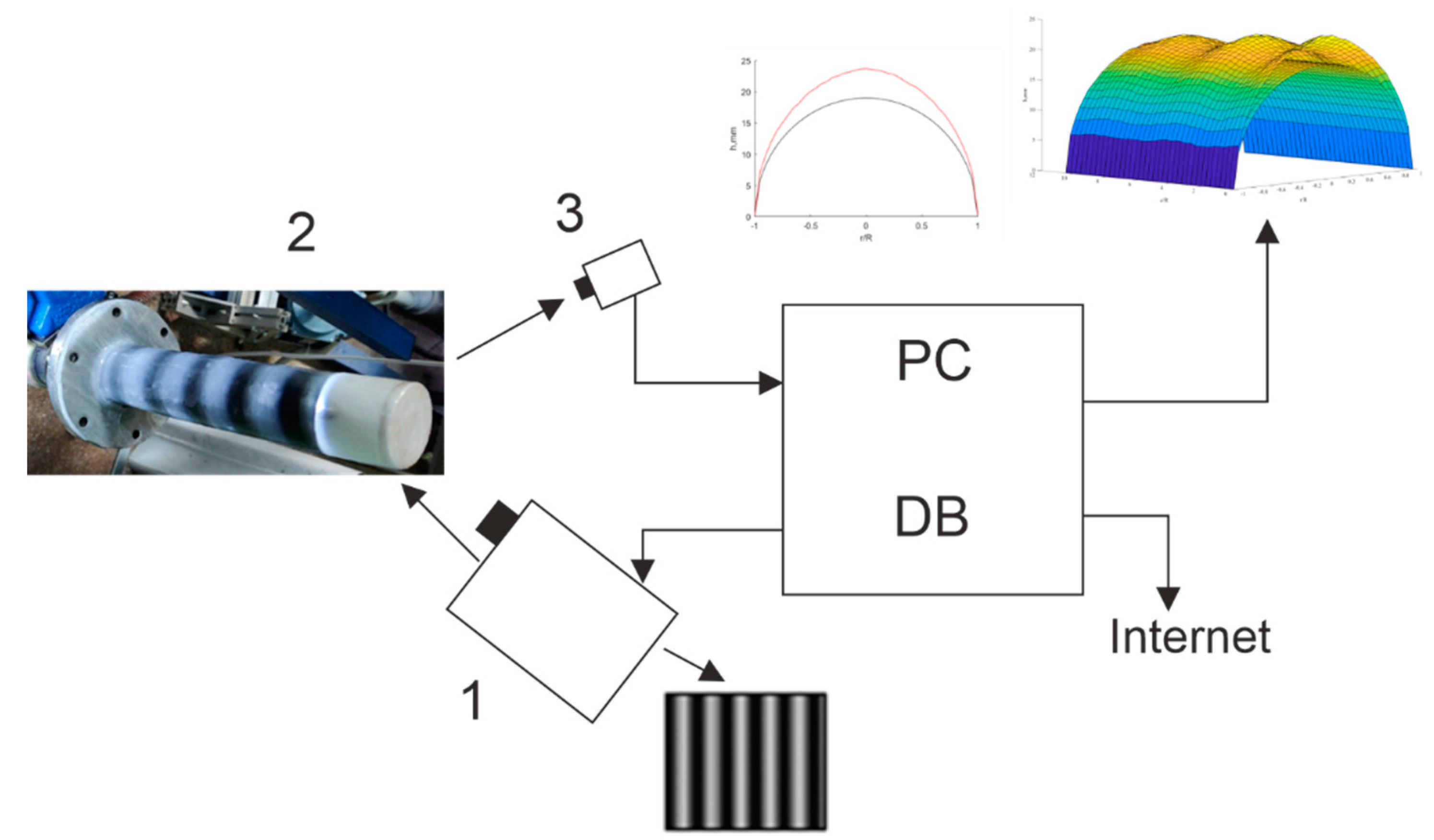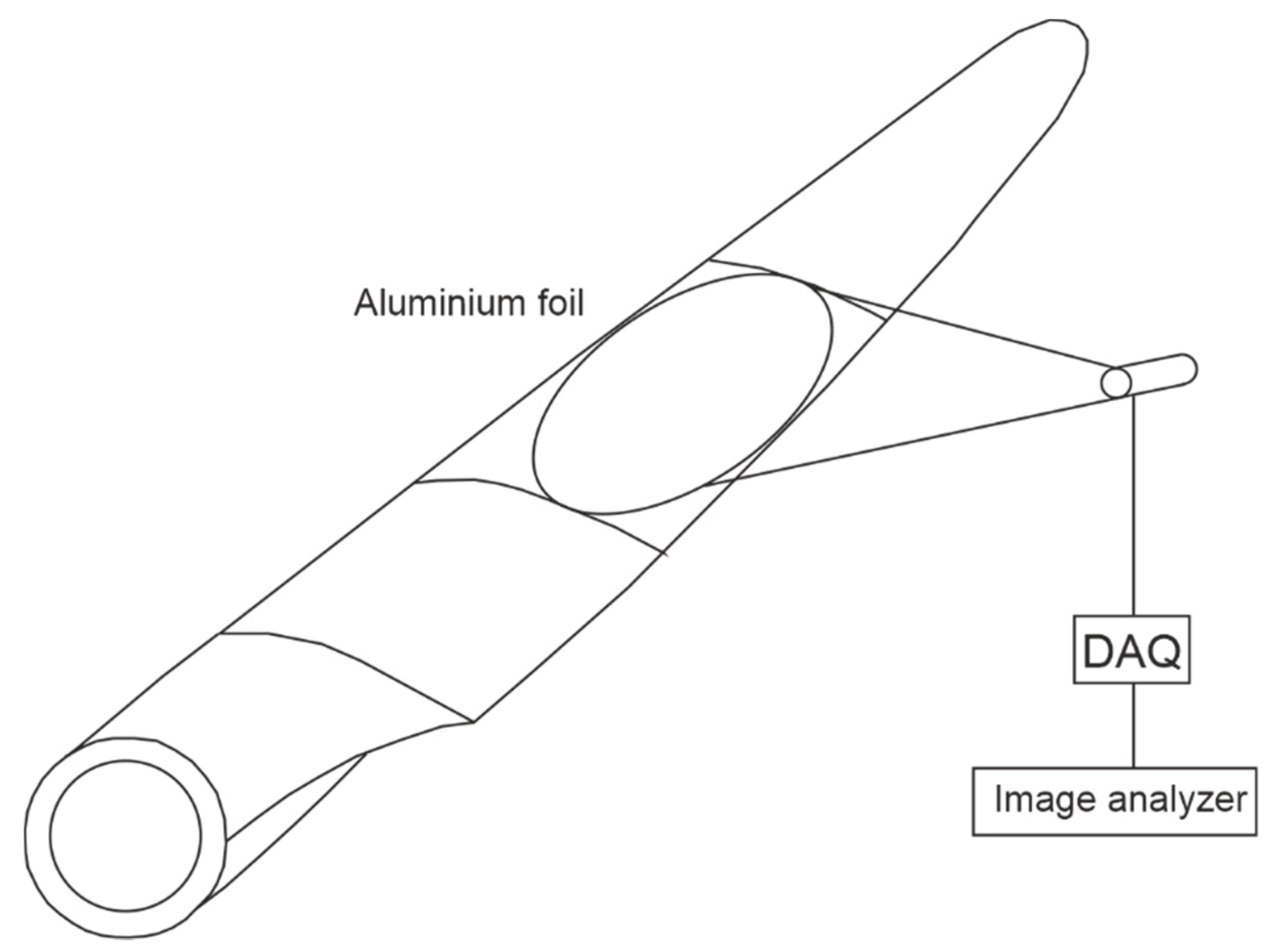Optical Methods for Measuring Icing of Wind Turbine Blades
Abstract
:1. Introduction
2. Indirect Methods for Determining to Ice
3. Direct Methods of Icing Diagnostics
3.1. Mechatronic Systems
3.2. Electrical Systems for Icing Diagnostics
4. Optical Methods of Icing Diagnostics
5. Discussion
6. Conclusions
Author Contributions
Funding
Institutional Review Board Statement
Informed Consent Statement
Data Availability Statement
Acknowledgments
Conflicts of Interest
References
- Wind Europe. Wind Energy in Europe: Scenarios for 2030. Report. Available online: https://windeurope.org/wp-content/uploads/files/about-wind/reports/Wind-energy-in-Europe-Scenarios-for-2030.pdf (accessed on 24 August 2021).
- National Energy Board. Canada’s Energy Future: Energy Supply and Demand Projections to 2035, an Energy Market. Available online: https://www.cer-rec.gc.ca/en/data-analysis/canada-energy-future/archive/2011/nrgsppldmndprjctn2035-eng.pdf (accessed on 24 August 2021).
- Technical Research Centre of Finland (VTT). Cold Climate Wind Energy Showing Huge Potential. Science Daily. 2013. Available online: https://www.sciencedaily.com/releases/2013/05/130528091611.htm (accessed on 24 August 2021).
- Kabardin, I.K. Development and Application of Optical-Laser Techniques for Improving the Efficiency of Wind Generators. Ph.D. Thesis, Minisy of Education of Russian Federation, Novosibirsk, Russia, 30 January 2015. [Google Scholar]
- Etemaddar, M.; Hansen, M.O.L.; Moan, T. Wind turbine aerodynamic response under atmospheric icing conditions. Wind Energy 2014, 17, 241–265. [Google Scholar] [CrossRef]
- Tammelin, B.; Böhringer, A.; Cavaliere, M.; Holttinen, H.; Morgan, C.; Seifert, H.; Säntti, K.; Vølund, P. Wind Energy Production in Cold Climate (WECO); Finnish Meteorological Institute: Helsinki, Finland, 2000; Available online: https://backend.orbit.dtu.dk/ws/portalfiles/portal/167477321/26134.pdf (accessed on 24 August 2021).
- Jasinski, W.J.; Noe, S.C.; Selig, M.S.; Bragg, M.B. Wind turbine performance under icing conditions. Trans. ASME J. Sol. Energy Eng. 1998, 120, 60–65. [Google Scholar] [CrossRef]
- Turkia, V.; Huttunen, S.; Thomas, W. Method for Estimating Wind Turbine Production Losses Due to Icing; VTT Technical Research Centre of Finland: Espo, Finland, 2013; Available online: https://www.vttresearch.com/sites/default/files/pdf/technology/2013/T114.pdf (accessed on 24 August 2021).
- Homola, M. Impacts and Causes of Icing on Wind Turbines; Narvik University College: Narvik, Norway, 2005; pp. 1–15. Available online: https://www.yumpu.com/en/document/read/20800745/impacts-and-causes-of-icing-on-wind-turbines (accessed on 24 August 2021).
- Siefert, H. Technical requirements for rotor blades operating in cold climate. Wind. Eng. 2003, 23, 69–79. [Google Scholar]
- Homola, M.C.; Nicklasson, P.B.; Sundsbø, A. Ice sensors for wind turbines. Cold Reg. Sci. Technol. 2006, 6, 125–131. [Google Scholar] [CrossRef]
- Madi, E.; Pope, K.; Huang, W.; Iqbal, K. A review of integrating ice detection and mitigation for wind turbine blades. Renew. Sustain. Energy Rev. 2019, 103, 269–281. [Google Scholar] [CrossRef]
- Wei, K.; Yang, Y.; Zuo, H.; Zhong, D. A review on ice detection technology and ice elimination technology for wind turbine. Wind Energy 2020, 23, 433–457. [Google Scholar] [CrossRef]
- Battisti, L. Wind turbines in cold climates: Icing impacts and mitigation systems. In Green Energy and Technology; Springer: New York, NY, USA, 2015. [Google Scholar]
- Mughal, U.; Virk, M.; Mustafa, M. State of the art review of atmospheric icing sensors. Sens. Transducers 2016, 198, 2–15. [Google Scholar]
- Rastayesh, S.; Long, L.; Dalsgaard Sørensen, J.; Thöns, S. Risk assessment and value of action analysis for icing conditions of wind turbines close to highways. Energies 2019, 12, 2653. [Google Scholar] [CrossRef] [Green Version]
- Zhang, L.; Liu, K.; Wang, Y.; Omariba, Z.B. Ice detection model of wind turbine blades based on random forest classifier. Energies 2018, 11, 2548. [Google Scholar] [CrossRef] [Green Version]
- Makkonen, L.; Laakso, T.; Säntti, K. Humidity in icing conditions. In Proceedings of the 2005 BOREAS VII, Saariselkä, Finland, 7–8 March 2005. [Google Scholar]
- Vetelino, K.A.; Story, P.R.; Mileham, R.D.; Galipeau, D.W. Improved dew point measurements based on a SAW sensor. Sens. Actuators 1996, 35, 198. [Google Scholar] [CrossRef]
- Laakso, T.; Holttinen, H.; Ronsten, G.; Tallhaug, L.; Horbaty, R.; Baring-gould, I.; Lacroix, A.; Peltola, E.; Tammelin, B. State-of-the-Art of Wind Energy in Cold Climates. 2003. Available online: https://www.semanticscholar.org/paper/State-of-the-art-of-wind-energy-in-cold-climates-Wallenius/1843e7da6ad95c6ceee0d6ee8278846dec79a97a64 (accessed on 20 August 2021).
- Carlsson, V. Measuring Routines of Ice Accretion for Wind Turbine Applications: The Correlation of Production Losses and Detection of Ice; Umeå University: Umeå, Sweden, 2010; Available online: https://www.diva-portal.org/smash/get/diva2:370953/FULLTEXT01.pdfViktor (accessed on 20 August 2021).
- Craig, D.; Craig, D. An investigation of icing events on Haeckel hill. In Proceedings of the 1995 BOREAS III Conference, Saariselkä, Finland, 19–21 March 1996; pp. 149–155. [Google Scholar]
- Roberge, P.; Lemay, J.; Ruel, J.; Bégin-Drolet, A. A new atmospheric icing detector based on thermally heated cylindrical probes for wind turbine applications. Cold Reg. Sci. Technol. 2018, 148, 131–141. [Google Scholar] [CrossRef]
- Skrimpas, G.A.; Kleani, K.; Mijatovic, N.; Sweeney, C.W.; Jensen, B.B.; Holboell, J. Detection of icing on wind turbine blades by means of vibration and power curve analysis. Wind Energy 2016, 19, 1819–1832. [Google Scholar] [CrossRef]
- Björkman, M. Long time measurements of noise from wind turbines. J. Sound Vib. 2004, 277, 567–572. [Google Scholar] [CrossRef]
- Szasz, R.Z.; Ronnfors, M.; Revstedt, J. Influence of ice accretion on the noise generated by an airfoil section. Int. J. Heat Fluid Flow 2016, 62, 83–92. [Google Scholar] [CrossRef]
- Luukkala, M. Detector for Indicating Ice Formation on the Wing of an Aircraft. U.S. Patent 5,467,944, 21 November 1995. [Google Scholar]
- Venna, S.; Lin, Y.J.; Botura, G. Piezoelectric transducer actuated leading edge de-icing with simultaneous shear and impulse forces. J. Aircr. 2007, 44, 509–515. [Google Scholar] [CrossRef]
- Wang, P.; Zhou, W.; Bao, Y. Ice monitoring of a full—Scale wind turbine blade using ultrasonic guided waves under varying temperature conditions. Struct. Control. Health Monit. 2018, 25, 2138. [Google Scholar] [CrossRef]
- Xu, B.; Guo, X.; Chen, H. Active icing monitoring for wind turbine blade models with PZT technology. Piezoelectrics Acoustooptics 2017, 39, 72–76. [Google Scholar]
- Xu, B.; Lu, F.; Dyke, S.J.; Guo, X. Icing monitoring for a wind turbine model blade with active PZT technology. In Proceedings of the Earth and Space 2014: Engineering for Extreme Environments, St. Louis, MO, USA, 27–29 October 2014. [Google Scholar] [CrossRef]
- Chamuel, J.R. Ultrasonic Aircraft Ice Detector Using Flexural Waves. U.S. Patent 4,461,178, 24 July 1984. [Google Scholar]
- Muñoz, C.Q.G.; Jiménez, A.A.; Márquez, F.P.G. Wavelet transforms and pattern recognition on ultrasonic guides waves for frozen surface state diagnosis. Renew. Energy 2018, 116, 42–54. [Google Scholar] [CrossRef]
- Ryerson, C.C. Assessment of Superstructure Ice Protection as Applied to Offshore Oil Operations Safety. 2009. Available online: https://digitalcommons.unl.edu/usarmyresearch/49/ (accessed on 24 August 2021).
- MacKenzie, I.K. Method and Apparatus for Measuring Ice Thickness on Substrates Using Backscattering of Gamma Rays. US Patent number 5,821,862, 13 October 1998. [Google Scholar]
- Geraldi, J.J.; Hickman, G.A.; Khatkhate, A.A.; Pruzan, D.A. Measuring Ice Distribution on a Surface with Attached Capacitance Electrodes. U.S. Patent number 5,551,288, 20 March 1996. [Google Scholar]
- Mughal, U.; Virk, M.S.; Mustafa, M. Electromagnetism based atmospheric ice sensing technique—A conceptual review. Multiphysics 2012, 6, 341–354. [Google Scholar] [CrossRef]
- Weinstein, L. Ice Sensor. US Patent number 4,766,369, 23 August 1988. [Google Scholar]
- Roggen, A. An overview of dielectric measurements. IEEE Trans. Electr. Insul. 1990, 25, 95–106. [Google Scholar] [CrossRef]
- Seegmillar, H. Ice Detector and Deicing Fluid Effectiveness Monitoring System. US Patent 5,523,959, 4 June 1996. [Google Scholar]
- Wallace, R.W.; Reich, A.D.; Sweet, D.B.; Rauckhorst, R.L.; Terry, M.J.; Holyfield, M.E. Ice Thickness Detector. U.S. Patent 6,384,611, 7 May 2002. [Google Scholar]
- Wang, J.; Wang, J.; Shao, J.; Li, J. Image recognition of icing thickness on power transmission lines based on a least squares hough transform. Energies 2017, 10, 415. [Google Scholar] [CrossRef] [Green Version]
- Liu, Y.; Li, Q.; Farzaneh, M.; Du, B.X. Image characteristic extraction of ice-covered outdoor insulator for monitoring icing degree. Energies 2020, 13, 5305. [Google Scholar] [CrossRef]
- Shajiee, S.; Pao, L.Y.; Wagner, P.N.; Moore, E.D.; Robert, R. Direct ice sensing and localized closed loop heating for active de-icing of wind turbines blades. In Proceedings of the American Control Conference (ACC), Washington, DC, USA, 17–19 June 2013; pp. 634–639. [Google Scholar]
- Ikiades, A.A.; Spasopoulos, D.; Amoiropoulos, K.; Richards, T.; Howard, G.; Pfeil, M. Detection and rate of growth of ice on aerodynamic surfaces using its optical characteristics using its optical characteristics. Aircr. Eng. Aerosp. Technol. 2013, 85, 443–452. [Google Scholar] [CrossRef]
- Luo, N.; Vidal, Y.; Acho, L. Advances in Industrial Control: Wind Turbine Control and Monitoring; Springer: Cham, Switzerland, 2014; p. 462. [Google Scholar] [CrossRef]
- Feng, C.; Papachristou, C. Grey-model based ice prediction sensor system on wind turbine system. In Proceedings of the Aerospace and Electronics Conference (NAECON), Beijing, China, 9–12 July 2012. [Google Scholar] [CrossRef] [Green Version]
- Hackmeister, R.L. Optical Ice Sensors for Wind Turbine—Nacelles Wind Systems Magazine. 2010. Available online: https://www.windsystemsmag.com/optical-ice-sensors-for-wind-turbine-nacelles (accessed on 24 August 2021).
- Oberson, P.; Huttner, B.; Guinnard, O.; Guinnard, L.; Ribordy, G.; Gisin, N. Optical frequency domain reflectometry with a narrow linewidth fiber laser. IEEE Photonics Technol. Lett. 2000, 12, 867–869. [Google Scholar] [CrossRef]
- Kabardin, I.K.; Rahmanov, V.V.; Meledin, V.G.; Eliseev, I.A.; Dvoinishnikov, S.V. Modified absorption optical method for wavy liqui film diagnostion on a rotational disk. Thermophys. Aeromechanics 2012, 19, 89–95. [Google Scholar]
- Alekseenko, S.V.; Bobylev, A.V.; Evseev, A.R.; Karsten, V.M.; Markovich, D.M.; Tarasov, B.V. Measurements of the liquid-film thickness by a fiber-optic probe. Instrum. Exp. Tech. 2003, 46, 260–264. [Google Scholar] [CrossRef]
- Clark, M.; McCann, D.; Forde, M. Application of infrared thermography to the nondestructive testing of concrete and masonry bridges. NDT E Int. 2003, 36, 265–275. [Google Scholar] [CrossRef]
- Munoz, C.Q.G.; Marquez, F.P.G.; Tomas, S.J. Ice detection using thermal infrared radiometry on wind turbine blades. Measurement 2016, 93, 157–163. [Google Scholar] [CrossRef]
- Pappalardo, G.; Mineo, S.; Perriello, Z.S.; Cubito, A.; Calcaterra, D. Infrared thermography proposed for the estimation of the cooling rate index in the remote survey of rock masses. Int. J. Rocket. Mech. Minist. Sci. 2016, 83, 182–196. [Google Scholar] [CrossRef]
- Brandt, R.; Bird, C.; Neuer, G. Emissivity reference paints for high temperature applications. Measurement 2008, 41, 731–736. [Google Scholar] [CrossRef]
- Honnerova, P.; Vesely, Z.; Honner, M. Experimental mathematical model as a generalization of sensitivity analysis of high temperature spectral emissivity measurement method. Measurement 2016, 90, 475–482. [Google Scholar] [CrossRef]
- Ferrara, L.M.; Persechino, C.; Bishop, P. Remote sensing in environmental police investigations: Aerial platforms and an innovative application of thermography to detect several illegal activities. Environ. Monit. Assess. 2014, 186, 8291–8301. [Google Scholar] [CrossRef]
- Kabardin, I.K.; Dvoinishnikov, S.V.; Meledin, V.G.; Naumov, I.V. Remote monitoring of ice loading on wind turbine blades based on total internal reflection. J. Eng. Thermophys. 2016, 4, 504–508. [Google Scholar] [CrossRef]
- Gagnon, R.E.; Groves, J.; Pearson, W. Remote ice detection equipment—RIDE. Cold Reg. Sci. Technol. 2012, 72, 1–16. [Google Scholar] [CrossRef]
- Kabardin, I.K.; Naumov, V.G.; Dvoinishnikov, S.V. Optical Method for Measuring the Field of Thickness of the Clear Ice on the Blades of the Wind Generator. RU Patent 2644625, 15 August 2016. [Google Scholar]
- Zhang, K.; Wei, T.; Hu, H. An experimental investigation on the surface water transport process over an airfoil by using a digital image projection technique. Exp. Fluids 2015, 56, 1–16. [Google Scholar] [CrossRef]
- Gao, L.; Veerakumar, R.; Liu, Y.; Hu, H. Quantification of the 3D shapes of the ice structures accreted on a wind turbine airfoil model. Vis. Soc. Jpn. 2019, 22, 661–667. [Google Scholar] [CrossRef]
- Gao, L.; Liu, Y.; Hu, H. An experimental investigation on the dynamic glaze ice accretion process over a wind turbine airfoil surface. Int. J. Heat Mass Transf. 2020, 149, 119120. [Google Scholar] [CrossRef]
- Lee, S.; Broeren, A.; Addy, H.; Sills, R.; Pifer, E. Development of 3D ice accretion measurement method. In Proceedings of the 4th AIAA Atnisoheric and space Environment Conference, New Orleans, LA, USA, 5–28 June 2012; pp. 1–17. [Google Scholar]
- Dvoinishnikov, S.V.; Anikin, Y.A.; Kabardin, I.K.; Kulikov, D.V.; Meledin, V.G. An optoelectronic method of contactless measurement of the profile of the surface of large complexly shaped objects. Meas. Tech. 2016, 59, 1. [Google Scholar] [CrossRef]
- Dvoynishnikov, S.V.; Rakhmanov, V.V.; Kabardin, I.K.; Meledin, V.G. Phase triangulation method with spatial modulation frequency optimization. Meas. J. Int. Meas. Confed. 2019, 145, 63–70. [Google Scholar] [CrossRef]
- Dvoinishnikov, S.V.; Meledin, V.G.; Shepihin, I.V.; Kabardin, I.K.; Kulikov, D.V. Method for measuring three-dimensional geometry of convex and extended objects. RU 2708940 C1, 15 January 2019. [Google Scholar]
- Gong, X.; Bansmer, S. Laser scanning applied for ice shape measurements. Cold Reg. Sci. Technol. 2015, 115, 64–76. [Google Scholar] [CrossRef]




| The Method Name | Advantages | Disadvantages |
|---|---|---|
| The video recording method | Simple, capable to measure the ice present, in combination with image processing methods can measure several geometric parameters | Does not measure thickness, does not measure transparent glaze parameters |
| The method of optical reflectometry | High accuracy, determining the type and presence of ice, high sensitivity, low time response, high resolution, durable, can be integrated into the wind turbine | High cost, commercial inaccessibility |
| The absorption optical method | Remote measurements, accurate field ice thickness, the method speed is limited only by the recording camera. | Cannot be mounted into, works only for transparent icing |
| The fiber-optic method | Accuracy of measuring the ice thickness, high sensitivity, low time response, high resolution, durable, can be integrated into the wind turbine | High cost, commercial inaccessibility |
| The method of infrared spectroscopy | Possibility of remote measurements, high speed, high resolution, wide dynamic range, high sensitivity, high accuracy, ice presence and type detection, easy sensor installing and refitting | Low temperature measurement accuracy, motion significantly affects the measured data and its accuracy |
| The method of total internal light reflection | Accurate field measurements of ice thickness, remote measurements, and mounting into the wind turbine blade | Works only for transparent icing |
| The digital image projection method | Ice location, ice thickness and ice growth measurements, high accuracy, remote measurements | Cannot be embedded into the blade, works only for non-transparent icing |
| The phase triangulation method | Ice location, thickness and growth measurements, high accuracy, remote measurements, resistance to defocusing of the projected and detected optical images | Cannot be embedded into the blade, works only for non-transparent icing |
Publisher’s Note: MDPI stays neutral with regard to jurisdictional claims in published maps and institutional affiliations. |
© 2021 by the authors. Licensee MDPI, Basel, Switzerland. This article is an open access article distributed under the terms and conditions of the Creative Commons Attribution (CC BY) license (https://creativecommons.org/licenses/by/4.0/).
Share and Cite
Kabardin, I.; Dvoynishnikov, S.; Gordienko, M.; Kakaulin, S.; Ledovsky, V.; Gusev, G.; Zuev, V.; Okulov, V. Optical Methods for Measuring Icing of Wind Turbine Blades. Energies 2021, 14, 6485. https://doi.org/10.3390/en14206485
Kabardin I, Dvoynishnikov S, Gordienko M, Kakaulin S, Ledovsky V, Gusev G, Zuev V, Okulov V. Optical Methods for Measuring Icing of Wind Turbine Blades. Energies. 2021; 14(20):6485. https://doi.org/10.3390/en14206485
Chicago/Turabian StyleKabardin, Ivan, Sergey Dvoynishnikov, Maxim Gordienko, Sergey Kakaulin, Vadim Ledovsky, Grigoriy Gusev, Vladislav Zuev, and Valery Okulov. 2021. "Optical Methods for Measuring Icing of Wind Turbine Blades" Energies 14, no. 20: 6485. https://doi.org/10.3390/en14206485
APA StyleKabardin, I., Dvoynishnikov, S., Gordienko, M., Kakaulin, S., Ledovsky, V., Gusev, G., Zuev, V., & Okulov, V. (2021). Optical Methods for Measuring Icing of Wind Turbine Blades. Energies, 14(20), 6485. https://doi.org/10.3390/en14206485









